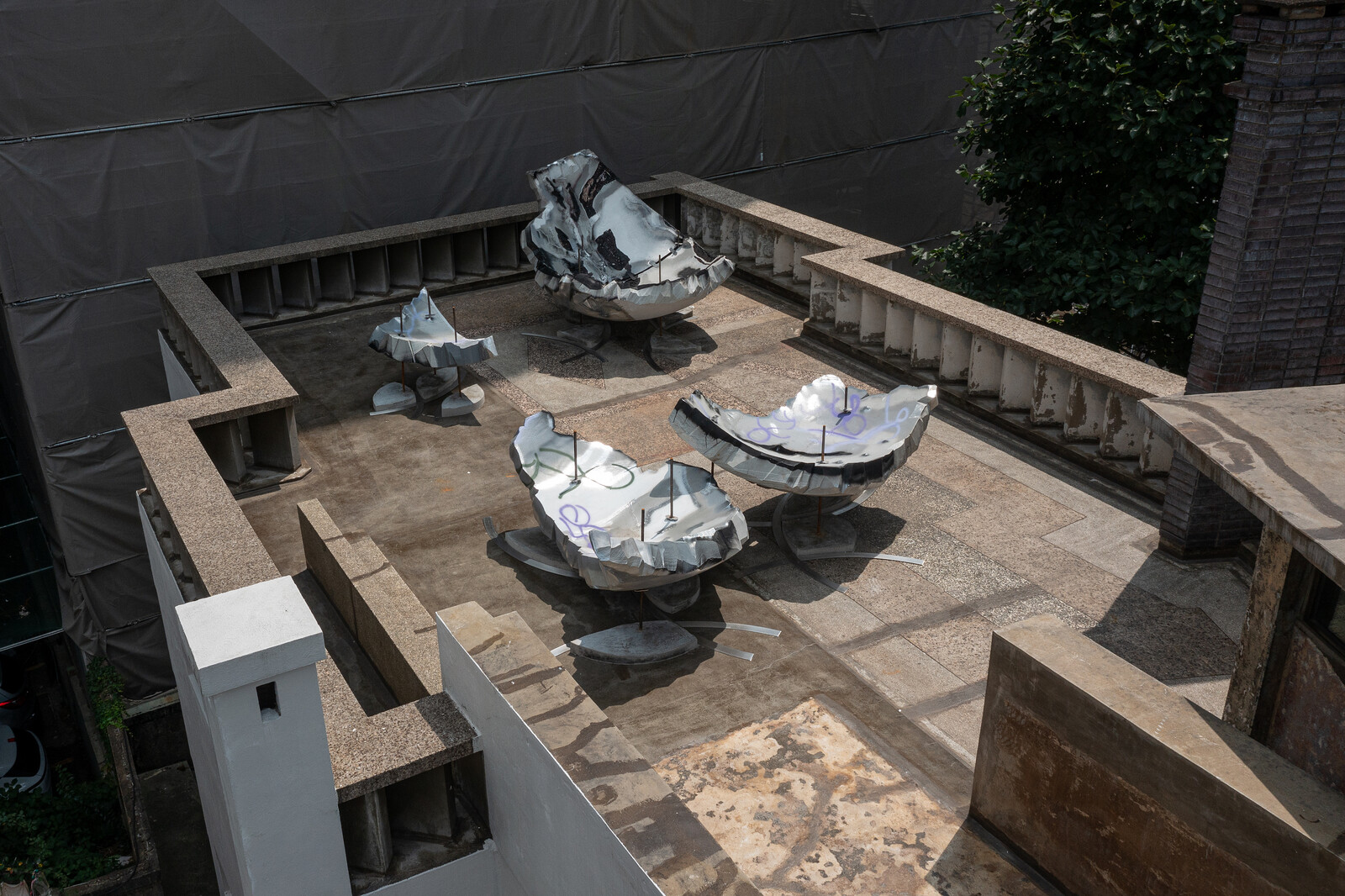August 17–October 20, 2024
In his posthumously published book Pirate Enlightenment, or the Real Libertalia (2023), David Graeber traces the impact that stories of Madagascar’s self-governing pirate settlements had upon the invention of Enlightenment reason in the seventeenth century, to make the point that much of what’s thought of as European or “western” thought in fact originates elsewhere.1 The late anthropologist’s concept of “pirate enlightenment” is a point of departure for “Seeing in the Dark,” on view at four venues in the South Korean port city of Busan.
What does it mean to see in the dark? Our pupils dilate in darkness, letting more light into our eyes. If we still can’t see, we turn to other senses: we listen, we feel. Many works in this biennial explore expanded ideas of visuality, or probe other strategies of multisensory perception. At Busan Museum of Contemporary Art, Sorawit Songsataya’s installation Two Bridges with 7 Notes and 42 Strings (2024) incorporates piles of dried fish and cuttlebone, gathered from Busan’s shorelines and busy markets, to evoke the scents of their granduncle’s fish sauce factory, associating their native Thailand with their family’s diasporic home in Aotearoa. Songsataya has put onyx crystals and dried plants on the sculpture Ranad (2024), which is made from Taranaki andesite and Ōamaru stone and shaped like the titular Thai xylophone, alerting us to the ways in which matter as dense and still as stone nonetheless vibrates.
Madagascar’s Malagasy queens—whose egalitarianism, Graeber wagers, inspired the island’s fabled pirate democracies—are the subject of textile collages by Dina Nomena Andriarimanjaka. Patterned drapery dangles from Les Invisibles (2023), ushering its subjects, a circle of women, into the space of the gallery. Douglas R. Ewart’s abstract painting Rasta in Sun Ra (2001) draws from Rastafari and Afrofuturist symbolism, while his self-made instruments, assembled out of found items like a crutch and a wooden ski, embody the ecstatic improvisation common to both of these genealogies of Black radical composition. We can link these artworks by observing, as Katherine McKittrick does, the connections between the conspiratorial whispers of insurrection and the “rebellious enthusiasms” of Black music, which both emerge in excess of, and ultimately restructure, dominant orders of knowledge.2
Buddhism came to Korea from China in the fourth century CE, and flourished until its Joseon era suppression. There’s a Mahayana sutra about a ship’s captain who kills a marauding pirate, accepting the bad karma to save their crew, and to stop the pirate from suffering even worse karma. With similar open-mindedness, “Seeing in the Dark” juxtaposes Buddhist and pirate conceptions of enlightenment. No real good can be secured by over-modesty (2024), an installation by Rajyashri Goody, features hundreds of bowls that, arranged upside down on the floor, resemble stupas. In a performance during the opening weekend, the artist continuously turned over these empty vessels—which sometimes rang, like a resting bell, as they reverberated on the wooden floor—in a meditation on the monastic act of begging and on Buddhism’s sacred circular forms, which symbolize the cycle of life and death.
These thematic focuses, which span the Indian Ocean, suggest a parallel for Afro Asia, a term describing the solidarities shared by African and Asian polities wrestling against European colonialism. Joan Kee has recently made the case for taking Afro Asia as an art-historical method, in which artworks advance a sovereignty analogous to that fought for by non-aligned nations during the Cold War.3 This method honors the art object’s autonomy, while striving to ensure that imperial values don’t overdetermine, or even deny, acts of interpretation.
Kee’s framework chimes with Shooshie Sulaiman and I Wayan Darmadi’s presentation PETA-One cloud, nine drops of rain (2024) at Choryang House. The artists communicate their journeying through Nusantara, a local name for the Malay Archipelago, with a distorted regional map, lo-fi photographic prints, and carved wooden masks. The work reminds us that the self-determination of peoples and places—and, for that matter, artworks—is an expression not only of their independence, but interdependence. On the building’s roof is Eugene Jung’s Fortune Earth (2022), a giant globe smashed into thick, craggy pieces. Europe’s Enlightenment has been justly criticized for the ways in which its universalist theories have fortified colonial epistemologies. Though conjuring an aura of catastrophe, Jung’s sculpture also asks what it means to see the planet in more pluralistic, and more provisional, terms.
At Busan Modern & Contemporary History Museum, Zishi Han’s sapphire blue video Moths (2024) documents, with an infra-red camera, a fluttering moth, an insect that pollinates at night. It’s accompanied by Exuviae (3 a.m.) (2024), a series of kinetic sculptures involving metal chains that droop from bass shakers, effecting an industrial buzz. Also shown in the basement gallery, a former bank vault, are photographs by Oladélé Ajiboyé Bamgboyé. The exuberant self-portraits in the “Celebrate” series (1997/2024), in which a nude Bamgboyé dances in a white studio trimmed with wrinkled streamers, feature up to eight frames (equivalent to a third of a second of film at a standard cinematic frame rate) superimposed upon each other, giving the stills a shimmering, blurred feel.
Graeber spoke of a “prefigurative” politics: one rooted in glimpses of a freer world, “full of all sorts of stumblings and false starts.”4 The principle is echoed in the Buddhist image of the beginner’s mind, free of preconceptions. Probing, and at times even a little raw, this biennial seeks not only to chart less-traveled trajectories of contemporary art, but to attune our senses anew.
David Graeber, Pirate Enlightenment, or the Real Libertalia (New York: Farrar, Straus and Giroux, 2023).
Katherine McKittrick, “Rebellion/Invention/Groove,” Small Axe, vol. 20, no. 1 (March 2016): 81.
Joan Kee, “Why Afro Asia,” October, no. 186 (October 2023): 137–162.
David Graeber, “The New Anarchists,” New Left Review, no. 13 (Jan/Feb 2002): 72.







